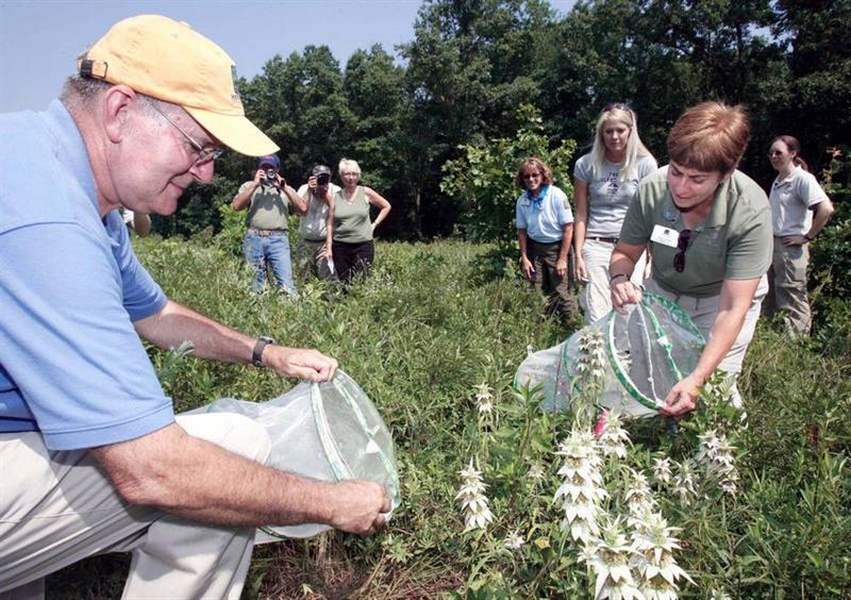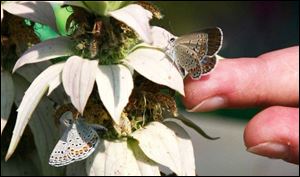
Toledo Zoo reintroduces Karner blues in park lands
7/11/2007
John F. Jaegger, director of natural resources, and Denise Gehring, director of environmental programs for the Toledo Area Metroparks, release endangered Karner blue butterflies at Oak Openings Metropark.

John F. Jaegger, director of natural resources, and Denise Gehring, director of environmental programs for the Toledo Area Metroparks, release endangered Karner blue butterflies at Oak Openings Metropark.
For Denise Gehring, this moment in a shadeless meadow under a merciless summer sun is the fulfillment of a dream.
Reaching into a barrel-shaped net cage, she proclaims, "They're coming out, everyone!"
Scores of eyeshadow-blue butterflies - small enough to hide behind a quarter - flutter forward like so many paper scraps.
"Good luck!" Ms. Gehring calls as some of the 131 Karner blue butterflies dance away.
In 1984, Ms. Gehring, director of environmental programs at the Toledo Area Metroparks, was among those who began the butterfly work. That was the year she and others began searching for the federally endangered butterfly.
There wasn't much to see. They began by identifying where lupine grows, looking for the little windows where Karner caterpillars chew into lupine leaves. Karner blues lay eggs on lupine exclusively. The developing grass-green caterpillar must have lupine to feed on in the three weeks before metamorphosis.
"We found three Karner blues at three different sites. They were all males," Ms. Gehring said. The following year, they found none.
The release at Oak Openings was the first on Metropark property.

Karner blue butterflies, hatched at the Toledo Zoo, are being reintroduced at three area Metroparks where the rare insects once thrived.
Peter Tolson, the Toledo Zoo's director of conservation, and Mitch Magditch, the zoo's director of education, created the butterfly breeding program, which has helped to return the Karner blue to the prairies of northwest Ohio.
Since 1998, the zoo has released 2,200 Karners in two Nature Conservancy properties, the Kitty Todd Preserve on Old Stateline Road in Swanton, and the adjacent Moseley Barrens. In fact, butterflies at the Kitty Todd site are now self-sustaining and haven't relied on an influx of zoo-raised butterflies since 2004.
The zoo's work is actually the spear point of the Ohio Karner Blue Butterfly Recovery Team effort that includes the Ohio Department of Natural Resources, the Nature Conservancy, the Ohio Lepidopterist Society, the Metroparks, the Toledo-Lucas County Port Authority, and the U.S. Fish and Wildlife Service.
The work is extending into Michigan through a cooperative arrangement with the Detroit Zoo. The Detroit institution plans to release Karner blues into a state game area in Petersburg next year.
A total of 250 Karner blues will be introduced at the Lou Campbell Prairie off Wilkins Road in the coming days. The prairie is named for the late Blade outdoors writer and conservationist who saw the scrub-covered field at this site and told park officials that with some careful burning, a rich prairie habitat would emerge. And it has.
Yesterday, the prairie was alive with butterflies of all varieties. Small copper butterflies were abundant at the Karner release site, many lighting on the 40 people gathered to witness the release, taking advantage of the salts in human perspiration. The surrounding field was full of glimmering black spicebush swallowtails, orange viceroys, and butter-yellow clouded sulphurs.
It took nine years to get the Karner blues back to the Metroparks since the last members of the species were seen there.
Metroparks had to manage that property in such a way the Karner blue would thrive there, Mr. Magditch said. Up until this point, it hadn t been ready.
It s ready now. At the end, Ms. Gehring urged a few reluctant blue butterflies to leave the net and head toward the lupines, which look like plants designed by Dr. Suess this time of year.
One little butterfly rose high into the air and headed away from the crowd, blending into the blue of the sky as it disappeared.
Live long and prosper, Ms. Gehring told the butterflies as they left. If the Karner blue is restored, than that means the habitat is restored.